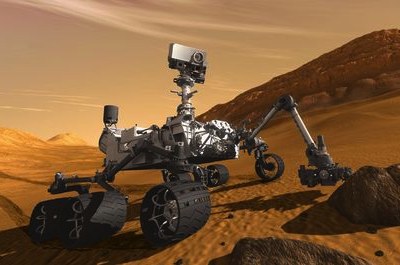Recalling the Mars flagshipsby Lou Friedman
|
| Having Europe turn to Russia because the US is too unreliable a launch partner! That is bad, but not as bad as watching the whole American Mars program, reinstituted in the 1990s after 20 years of stagnation, now coming apart. |
I can’t be sure that this episode of the past applies to the future of the United States, but I get a strong hint about its applicability when I see that the European Space Agency (ESA) has turned to Russia for future exploration of Mars, just as Russia is about to launch the first Chinese spacecraft to go to Mars. Europe is properly exasperated as the US backs off the nascent plan to explore Mars together with missions in 2016 and 2018. Just eight months ago the president’s budget to Congress proposed that for the 2016 mission, “ESA will provide the [Trace Gas Orbiter] spacecraft, and NASA will provide the launch vehicle. JPL will provide project management and implement the ESA/NASA contributions.” Both the House and Senate Appropriations Committees accepted this element of the Mars program (in the not-yet-passed fiscal year 2012 budget) but the administration’s Office of Management and Budget (OMB) has now reneged on the agreement by blocking its implementation. ESA is turning to Russia to see if they will launch the orbiter.
Does anyone in the Administration have a sense of irony? Having Europe turn to Russia because the US is too unreliable a launch partner! That is bad, but not as bad as watching the whole American Mars program, reinstituted in the 1990s after 20 years of stagnation, now coming apart. As I have said many times, it makes no difference to Mars when it is explored or by whom, but it makes a huge difference to us, the people who own the program and carry it out. Just as when, nearly 20 years ago, the US abandoned the Superconducting Supercollider effort, it is one more piece of evidence of a great country ceding its greatness and reducing its hopes and investments for the future. OMB’s recalling of the solar system flagships is perfectly analogous to Zhu Gaochi’s 15th century recall of China’s flagships. For those who like to think short-term only, it also reduces jobs and national capability. Universities and companies around the country have motivated academic achievement and inspirational jobs with Mars and other planetary exploration.
The ESA-Russia arrangement is a long shot. Russia is about to launch their first planetary mission in 15 years. If the Phobos sample return mission, with the piggybacked Chinese Mars orbiter, is successfully launched next month (the currently-planned launch date is November 8), then indeed prospects for international collaboration and a more resilient program will greatly increase. I’m vitally interested in that launch, but I find my personal interest to be only a minor part of the irony of having to see the hopes of the European and American Mars communities riding on that same Russian launch. Whatever happens, I hope the large community of Mars scientists around the world, many of whom participate in the NASA-sponsored Mars Exploration Program Analysis Group (MEPAG), will come together soon and address the crisis now facing the future of Mars exploration.
| How these events turn out will determine a lot—perhaps the very future of space exploration for our current generation. |
The dismantling of the Mars program in NASA is, sadly, only the tip of the iceberg. Further cuts to NASA’s budget are almost certainly coming. There is really no solution that can fund both the James Webb Space Telescope and save planetary exploration, except one: delay the premature and wildly expensive Space Launch System. A two-year delay would actually benefit the human space exploration program because it would permit evaluation of the in-orbit refueling option, which a recent NASA report has found could be a less expensive way to achieve deep space human spaceflight. The combination of a lower cost deep space rocket and a publicly engaging Mars exploration program should allow human exploration beyond Earth orbit to take place not only more quickly but also with a stronger rationale. That makes it sustainable. NASA would be inspiring the public with a next-generation space telescope and the collection and analysis of samples on the surface of Mars in this coming decade. The alternative is NASA in crisis, spending too much to do too little and going nowhere. This was the president’s plan with robotic and human exploration advancing together into the solar system. OMB should return to it and honor the administration’s commitment made a few months ago for American participation in the international exploration of Mars.
Next month is a big one: Russia’s Phobos-Grunt sample return mission is set to launch November 8, Mars Science Laboratory’s launch period begins November 25, and the NASA-ESA agreement to conduct 2016/2018 missions will either be honored or dismantled. How these three events turn out will determine a lot—perhaps the very future of space exploration for our current generation.
